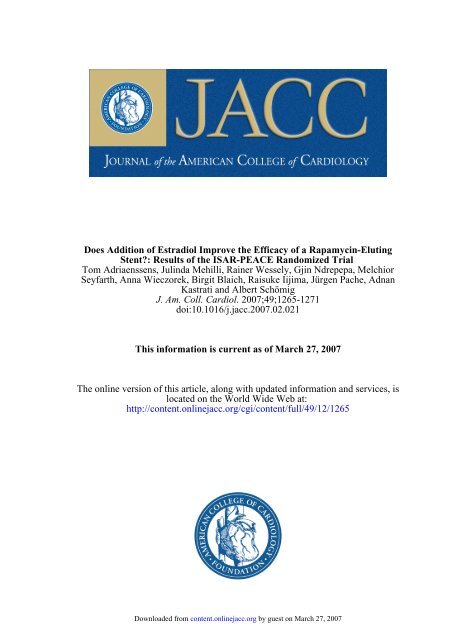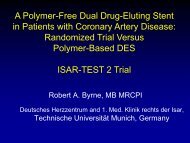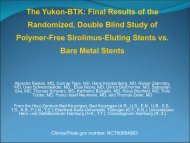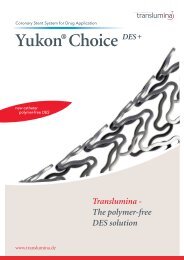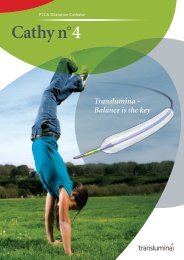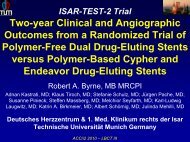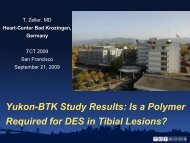PDF download - Translumina
PDF download - Translumina
PDF download - Translumina
Create successful ePaper yourself
Turn your PDF publications into a flip-book with our unique Google optimized e-Paper software.
Does Addition of Estradiol Improve the Efficacy of a Rapamycin-Eluting<br />
Stent?: Results of the ISAR-PEACE Randomized Trial<br />
Tom Adriaenssens, Julinda Mehilli, Rainer Wessely, Gjin Ndrepepa, Melchior<br />
Seyfarth, Anna Wieczorek, Birgit Blaich, Raisuke Iijima, Jürgen Pache, Adnan<br />
Kastrati and Albert Schömig<br />
J. Am. Coll. Cardiol. 2007;49;1265-1271<br />
doi:10.1016/j.jacc.2007.02.021<br />
This information is current as of March 27, 2007<br />
The online version of this article, along with updated information and services, is<br />
located on the World Wide Web at:<br />
http://content.onlinejacc.org/cgi/content/full/49/12/1265<br />
Downloaded from<br />
content.onlinejacc.org by guest on March 27, 2007
Journal of the American College of Cardiology Vol. 49, No. 12, 2007<br />
© 2007 by the American College of Cardiology Foundation ISSN 0735-1097/07/$32.00<br />
Published by Elsevier Inc. doi:10.1016/j.jacc.2007.02.021<br />
LATE-BREAKING CLINICAL TRIALS<br />
Does Addition of Estradiol Improve<br />
the Efficacy of a Rapamycin-Eluting Stent?<br />
Results of the ISAR-PEACE Randomized Trial<br />
Tom Adriaenssens, MD, Julinda Mehilli, MD, Rainer Wessely, MD, Gjin Ndrepepa, MD,<br />
Melchior Seyfarth, MD, Anna Wieczorek, Birgit Blaich, PHD, Raisuke Iijima, MD, Jürgen Pache, MD,<br />
Adnan Kastrati, MD, Albert Schömig, MD<br />
Munich, Germany<br />
Objectives This study aimed to assess the efficacy of a rapamycin plus 17-�-estradiol–eluting stent versus a rapamycineluting<br />
stent in patients with coronary artery disease.<br />
Background Estradiol promotes rapid re-endothelialization of coronary stents in animal models, but it is not known whether<br />
combining this drug with rapamycin represents an improved drug-eluting stent technology in terms of reduced<br />
lumen renarrowing.<br />
Methods In this randomized study, we enrolled 502 patients with de novo lesions in native coronary arteries who were<br />
randomly assigned to receive either a polymer-free, estradiol plus rapamycin-eluting stent (ERES) (n � 252) or a<br />
polymer-free, rapamycin-eluting stent (RES) (n � 250). The primary end point was in-stent late lumen loss in the<br />
follow-up angiography. Secondary end points were binary angiographic restenosis, target lesion revascularization,<br />
combined incidence of death and myocardial infarction, and incidence of stent thrombosis during 1 year<br />
after randomization. The study was designed to test for the superiority of the ERES compared with the RES with<br />
respect to in-stent late lumen loss.<br />
Results Late lumen loss (0.52 � 0.58 mm vs. 0.51 � 0.58 mm, p � 0.83), the incidence of binary angiographic restenosis<br />
(17.6% vs. 16.9%, p � 0.85), the incidence of target lesion revascularization (14.3% vs. 13.2%, p � 0.72),<br />
the combined incidence of death and myocardial infarction (7.9% vs. 8.0%, p � 0.98), and the incidence of<br />
stent thrombosis (0.8% vs. 1.2%, p � 0.99) were not significantly different between the ERES group and the RES<br />
group.<br />
Conclusions No apparent beneficial effect is obtained by adding estradiol to a polymer-free rapamycin-eluting stent during<br />
the first year after the procedure. (The ISAR-PEACE trial; http://clinicaltrials.gov/ct/show/NCT00402636?<br />
order�1; NCT00402636) (J Am Coll Cardiol 2007;49:1265–71) © 2007 by the American College of Cardiology<br />
Foundation<br />
The use of drug-eluting stents (DES) has reduced the need<br />
for reintervention compared with bare-metal stents (BMS)<br />
(1). Despite these results, there is an intense ongoing debate<br />
on an increased risk of late stent thrombosis, particularly<br />
after discontinuation of thienopyridine therapy, and delayed<br />
onset of restenosis, or catch-up phenomenon, with DES<br />
(2–4). Lack of or delayed endothelialization associated with<br />
DES is considered an important factor that may precipitate<br />
From the Deutsches Herzzentrum, Technische Universtität, Munich, Germany. Dr.<br />
Kastrati reports receiving lecture fees from Bristol-Myers Squibb, Cordis, Glaxo-<br />
SmithKline, Lilly, Medtronic, Novartis, and Sanofi-Aventis. Dr. Schömig reports<br />
receiving unrestricted grant support for the Department of Cardiology he chairs from<br />
Amersham/General Electric, Bayerische Forschungsstiftung, Bristol-Meyers Squibb,<br />
Cordis, Cryocath, Guidant, Medtronic, Nycomed, and Schering.<br />
Manuscript received February 12, 2007; accepted February 16, 2007.<br />
Downloaded from<br />
content.onlinejacc.org by guest on March 27, 2007<br />
late stent thrombosis (5). There are limited data regarding<br />
the effect of rapamycin on endothelial (re)growth (6).<br />
Recent findings from a human study suggest that endothelial<br />
dysfunction is frequently apparent after implantation of<br />
a sirolimus-eluting stent (7). In addition, there is strong<br />
evidence that a rapid re-endothelialization attenuates neointima<br />
formation after vascular injury (8,9), and promotion<br />
of endothelial recovery is regarded as the next target for<br />
restenosis (10). Estradiol has been shown to promote rapid<br />
re-endothelialization of the stent and to reduce restenosis<br />
after percutaneous coronary interventions (PCIs) in animal<br />
models (11–13). Thus, by promoting re-endothelialization,<br />
estradiol has the potential of favorably affecting the risk of<br />
thrombosis and restenosis after DES implantation. It may<br />
serve as a useful adjunct to rapamycin with established<br />
pronounced antiproliferative effects.
1266 Adriaenssens et al. JACC Vol. 49, No. 12, 2007<br />
Rapamycin Plus Estradiol-Eluting Stent March 27, 2007:1265–71<br />
Abbreviations<br />
and Acronyms<br />
ARC � Academic Research<br />
Consortium<br />
BMS � bare-metal stent(s)<br />
DES � drug-eluting stent(s)<br />
ERES � estradiol plus<br />
rapamycin-eluting stent(s)<br />
IVUS � intravascular<br />
ultrasound<br />
PCI � percutaneous<br />
coronary intervention<br />
RES � rapamycin-eluting<br />
stent(s)<br />
We designed a randomized<br />
study to compare the efficacy of<br />
a polymer-free, estradiol plus<br />
rapamycin-eluting stent (ERES)<br />
with that of a polymer-free,<br />
rapamycin-eluting stent (RES)<br />
in patients with coronary artery<br />
disease. The stent platform used<br />
was a microporous stainless steel<br />
stent that allows for a polymerfree<br />
drug coating.<br />
Methods<br />
Study population and protocol.<br />
Patients who were at least 18<br />
years old, had stable or unstable angina or a positive stress<br />
test, and were to undergo PCIs for de novo lesions in a<br />
native coronary artery were considered eligible for this<br />
study. Pregnant women; patients with an acute ST-segment<br />
elevation myocardial infarction; malignancies or other comorbid<br />
conditions with a life expectancy �12 months;<br />
target lesion located in the left main trunk; and a contraindication<br />
or known allergy to aspirin, heparin, thienopyridines,<br />
rapamycin, estradiol, or stainless steel were considered<br />
ineligible for the study. The study protocol was<br />
approved by the local ethics committee. All patients gave<br />
their written informed consent for participation in this trial.<br />
At least 2 h before undergoing catheterization, patients<br />
received a loading dose of 600 mg of clopidogrel. Randomization<br />
was performed after wiring of the target vessel using<br />
sealed, opaque envelopes containing a computer-generated<br />
random sequence. No stratification was performed. Patients<br />
were assigned to receive either ERES or RES. The stent<br />
platform used in this study has been described in detail<br />
previously (14,15). Both rapamycin and estradiolvalerat<br />
were in 1% concentrations.<br />
For determination of pharmacologic release kinetics,<br />
ERES and RES (n � 3 for each group) were deployed ex<br />
vivo and incubated in 1 ml of phosphate-buffered saline at<br />
37°C in screw-cap tubes. Samples harvested at the indicated<br />
time points were subjected to ultraviolet spectrophotometric<br />
analysis by using a SAFIRE multiplate reader (Tecan<br />
Schweiz Trading AG, Männedorf, Switzerland). A calibration<br />
curve was established by use of the peak absorbance<br />
wavelength of 280 nm (A 280) for rapamycin in phosphatebuffered<br />
saline and served as a basis for the calculation of<br />
respective concentrations and, hence, of total amounts of<br />
the substance in each sample. Interference of absorption<br />
measurement by estradiolvalerat at 280 nm was ruled out by<br />
comparison of A 280 of stock solutions containing either<br />
rapamycin alone (1%) or a mixture of rapamycin and<br />
estradiolvalerat (1%/1%) showing virtually the same values<br />
for both samples (data not shown). This is due to a<br />
considerably lower absorbance level of estradiolvalerat at<br />
280 nm compared with rapamycin at the same concentra-<br />
tion. Figure 1 shows a marked slower release of rapamycin<br />
from ERES. At 1 month, total release of rapamycin was<br />
95% from RES and 60% from ERES.<br />
Aspirin and unfractionated heparin were administered per<br />
standard practice; the use of abciximab (ReoPro, Lilly, Bad<br />
Homburg, Germany) was generally restricted to patients with<br />
acute coronary syndromes (positive troponin or ST-segment<br />
depression on surface electrocardiogram). After the procedure,<br />
patients were maintained on aspirin 100 mg twice daily indefinitely,<br />
and clopidogrel 75 mg twice daily until discharge and 75<br />
mg daily for at least 6 months. Other medicaments such as<br />
beta-blockers, statins, and angiotensin-converting enzyme inhibitors<br />
were given as indicated. After enrollment, patients remained<br />
in hospital for at least 48 h. Electrocardiograms were recorded,<br />
and blood was collected for determination of creatine kinase and<br />
its MB isoenzyme before randomization, and every 8 h for the first<br />
24 h after randomization and daily until hospital discharge.<br />
Clinical follow-up by phone contact was scheduled at 1 and 12<br />
months. All patients were asked to return for repeat coronary<br />
angiography between 6 and 8 months after randomization or<br />
earlier, if anginal symptoms had developed.<br />
Data management, end points, and definitions. Relevant<br />
data were collected and entered into a computer database by<br />
specialized personnel of the ISAR (Intracoronary Stenting<br />
and Angiographic Restenosis) Center. All data were verified<br />
against source documentation, and all adverse events were<br />
adjudicated by an event committee blinded to treatment<br />
allocation. Baseline, postprocedural, and follow-up cineangiograms<br />
were forwarded to the Quantitative Angiographic<br />
Core Laboratory (ISAR Center, Munich, Germany) for<br />
assessment by experienced technicians unaware of the treatment<br />
allocation. Angiographic image acquisition of the<br />
target lesion was done after intracoronary administration of<br />
Figure 1<br />
Release Kinetics of Rapamycin<br />
From the ERES and RES<br />
Downloaded from<br />
content.onlinejacc.org by guest on March 27, 2007<br />
Kinetics are displayed as cumulative release of rapamycin over time in percent<br />
of total rapamycin on the stents (� SD). ERES � estradiol plus rapamycineluting<br />
stent; RES � rapamycin-eluting stent.
JACC Vol. 49, No. 12, 2007 Adriaenssens et al.<br />
March 27, 2007:1265–71 Rapamycin Plus Estradiol-Eluting Stent<br />
nitroglycerin, and the same single worst view projection was<br />
measured at all time points. Qualitative morphologic lesion<br />
characteristics were characterized using standard criteria<br />
(16). Off-line quantitative coronary angiographic analysis<br />
was performed using the automated edge detection system<br />
(QCA-CMS version 6.0, Medis, Medical Imaging Systems,<br />
Leiden, the Netherlands). The contrast-filled non-tapered<br />
catheter tip was used for calibration. The reference diameter<br />
was measured by interpolation. Minimal lumen diameter<br />
was measured within the stent and within the 5-mm<br />
proximal and distal edges of the stent. Quantitative analysis<br />
was performed in the in-stent area (in-stent analysis) and in<br />
the in-segment area including the stented segment as well as<br />
both 5-mm margins proximal and distal to the stent<br />
(in-segment analysis).<br />
The primary end point of the study was in-stent late<br />
lumen loss. Secondary end points were the binary angiographic<br />
restenosis (diameter stenosis of at least 50% based<br />
on in-segment analysis) at follow-up angiography, the need<br />
for target lesion revascularization due to restenosis in the<br />
presence of symptoms or signs of ischemia, the combined<br />
incidence of death and myocardial infarction, and the<br />
incidence of stent thrombosis during the 12-month followup.<br />
The diagnosis of myocardial infarction required the<br />
presence of new Q waves in the electrocardiogram and/or<br />
elevation of creatine kinase or its MB isoenzyme at least 3<br />
times the upper limit of normal in �2 blood samples. Stent<br />
thrombosis was defined as a target lesion occlusion with<br />
Thrombolysis In Myocardial Infarction flow grade 0 or 1<br />
accompanied by angiographically visible thrombus and/or<br />
acute coronary syndrome. Retrospectively, stent thrombosis<br />
was also assessed based on the definitions of the Academic<br />
Research Consortium (ARC) (17).<br />
Statistical methods. The study hypothesis was that ERES<br />
was superior to RES in terms of decreased late lumen loss.<br />
Figure 2 Flow Chart of Study Participants<br />
Downloaded from<br />
content.onlinejacc.org by guest on March 27, 2007<br />
1267<br />
Assuming a late lumen loss of 0.48 mm with the RES and<br />
choosing a power of 80%, 190 patients were required in each<br />
group to demonstrate a significant difference of 0.16 mm in<br />
favor of ERES at a 2-sided alpha level of 0.05. We enrolled<br />
a total of 502 patients to accommodate for possible missing<br />
follow-up angiograms.<br />
The analyses were performed on an intention-to-treat<br />
basis. In patients with multilesion interventions, only the<br />
first treated lesion that served for randomization was included<br />
in the analysis. Categoric variables are summarized<br />
as counts or percentages and compared using chi-square or<br />
Fisher exact test (when expected cell values were �5).<br />
Continuous variables are expressed as mean � SD and<br />
compared with the Student t test. Survival analysis was<br />
performed by applying the Kaplan-Meier method; differences<br />
in survival parameters were checked for significance by<br />
the log-rank test. All analyses were performed using S-Plus<br />
4.5 statistical package (Insightful Corp., Seattle, Washington).<br />
A 2-sided p value �0.05 was considered to indicate<br />
statistical significance.<br />
Results<br />
Baseline characteristics and procedural results. A total of<br />
502 patients were enrolled in this study; 252 patients were<br />
assigned to the ERES group and 250 to the RES group.<br />
Figure 2 shows the flow chart of study participants. Baseline<br />
demographic and clinical data are shown in Table 1.<br />
Angiographic and procedural characteristics are shown in<br />
Table 2. Data were well matched between the 2 groups.<br />
Implantation of the assigned stent was successful in all but<br />
1 (99.6%) patient in the ERES group and in all patients in<br />
the RES group. Only a small proportion of patients received<br />
abciximab periprocedurally (Table 2).
1268 Adriaenssens et al. JACC Vol. 49, No. 12, 2007<br />
Rapamycin Plus Estradiol-Eluting Stent March 27, 2007:1265–71<br />
Baseline Demographic and Clinical Characteristics<br />
Table 1 Baseline Demographic and Clinical Characteristics<br />
Estradiol Plus<br />
Rapamycin<br />
Rapamycin Group<br />
Group<br />
Characteristic<br />
(n � 252)<br />
(n � 250) p Value<br />
Age (yrs) 66.3 � 10.3 67.4 � 10.5 0.24<br />
Women 56 (22) 64 (26) 0.37<br />
Diabetes mellitus 76 (30) 72 (29) 0.74<br />
Current smoker 48 (19) 45 (18) 0.76<br />
Arterial hypertension 156 (62) 166 (66) 0.29<br />
Hypercholesterolemia 154 (61) 172 (69) 0.07<br />
Unstable angina 79 (31) 73 (29) 0.60<br />
Non–ST-segment elevation myocardial infarction 59 (23) 50 (20) 0.35<br />
Prior myocardial infarction 80 (32) 84 (34) 0.66<br />
Prior aortocoronary bypass surgery 23 (9) 18 (7) 0.43<br />
Left ventricular ejection fraction (%) 55.6 � 10.9 53.5 � 13.0 0.06<br />
Serum creatinine (mg/dl) 1.02 � 0.55 1.08 � 0.56 0.20<br />
Data are mean � SD or number of patients (%).<br />
At discharge, beta-blockers (97.2% vs. 97.6%, p � 0.80),<br />
angiotensin-converting enzyme inhibitors (82.9% vs. 84.0%,<br />
p � 0.75), and statins (91.7% vs. 92.4%, p � 0.76) were<br />
prescribed in similar proportions of patients in the ERES<br />
and RES groups. There were also no significant differences<br />
between the 2 groups regarding the actual duration of<br />
clopidogrel therapy: 4 weeks in 0.4% and 1.2%, 6 months in<br />
19.4% and 17.2%, and 1 year in 80.2% and 81.6% in the<br />
ERES and RES groups, respectively (p � 0.50).<br />
Angiographic restenosis. Follow-up angiography was performed<br />
in 204 patients (81.0%) in the ERES group and in 201<br />
patients (80.4%) in the RES group (p � 0.97). Reasons for failure<br />
to perform follow-up angiography are shown in Figure 2.<br />
In-stent late lumen loss was 0.52 � 0.58 mm among<br />
patients in the ERES group and 0.51 � 0.58 mm among<br />
patients in the RES group (p � 0.83). Figure 3 shows the<br />
overlapping cumulative distribution curves of late lumen loss<br />
Angiographic and Procedural Data<br />
Table 2 Angiographic and Procedural Data<br />
in the 2 study groups. The other quantitative parameters of<br />
restenosis were also comparable between the 2 groups<br />
(Table 3). The incidence of binary angiographic restenosis<br />
was 17.6% in the ERES group and 16.9% in the RES group<br />
(p � 0.85) (Fig. 4).<br />
Stent thrombosis. According to the protocol-based definition,<br />
2 patients (0.8%) in the ERES group (22 and 249 day<br />
after DES implantation, respectively) and 3 patients (1.2%) in<br />
the RES group (1, 11, and 13 days after DES implantation,<br />
respectively) incurred stent thrombosis (p � 0.99) within 1<br />
year after randomization; all of these patients were on clopidogrel<br />
treatment as they incurred this complication.<br />
Using the ARC criteria, definite stent thrombosis was<br />
observed in 2 patients (0.8%) in the ERES group and 3<br />
patients (1.2%) in the RES group (p � 0.99). In addition,<br />
there were 6 cases of possible stent thrombosis (3 in each<br />
group) and no cases of probable stent thrombosis.<br />
Estradiol Plus<br />
Rapamycin<br />
Rapamycin Group<br />
Group<br />
Characteristic<br />
(n � 252)<br />
(n � 250) p Value<br />
Target vessel 0.30<br />
Left anterior descending coronary artery 95 (38) 107 (43)<br />
Left circumflex coronary artery 75 (30) 60 (24)<br />
Right coronary artery 82 (33) 83 (33)<br />
Complex (type B2/C) lesions 175 (69) 192 (77) 0.06<br />
Chronic total occlusions 6 (2) 6 (2) 0.99<br />
Vessel size (mm) 2.77 � 0.5 2.78 � 0.50 0.90<br />
Lesion length (mm) 13.5 � 7.2 12.6 � 6.2 0.17<br />
Initial minimal lumen diameter (mm) 1.08 � 0.46 1.10 � 0.50 0.63<br />
Initial diameter stenosis (%) 61.0 � 14.9 60.3 � 16.1 0.59<br />
Maximal balloon pressure (atm) 14.3 � 2.9 14.3 � 2.8 0.89<br />
Maximal balloon diameter (mm) 2.85 � 0.51 2.90 � 0.48 0.25<br />
Length of stented segment (mm) 21.6 � 7.9 21.3 � 8.6 0.69<br />
Final minimal lumen diameter (mm) 2.53 � 0.44 2.59 � 0.43 0.12<br />
Final diameter stenosis (mm) 10.8 � 5.9 9.9 � 6.1 0.11<br />
Periprocedural abciximab therapy 22 (8.7) 21 (8.4) 0.89<br />
Data are mean � SD or number of patients (%).<br />
Downloaded from<br />
content.onlinejacc.org by guest on March 27, 2007
JACC Vol. 49, No. 12, 2007 Adriaenssens et al.<br />
March 27, 2007:1265–71 Rapamycin Plus Estradiol-Eluting Stent<br />
Figure 3<br />
Clinical outcomes. Five patients (2.0%) in the ERES group<br />
and 6 patients (2.4%) in the RES group died at 1 year (p �<br />
0.75); all of them were on clopidogrel treatment when they<br />
died. The combined 12-month incidence of death and myocardial<br />
infarction was comparable between the 2 groups (7.9%<br />
in the ERES group versus 8.0% in the RES group, p � 0.98)<br />
(Fig. 5). Target lesion revascularization rate was 14.3% in the<br />
ERES group and 13.2% in the RES group (p � 0.72) (Fig. 4).<br />
Discussion<br />
Cumulative Frequency Curves of In-Stent Late Lumen<br />
Loss at Follow-Up Angiography for the 2 DES Groups<br />
DES � drug-eluting stent; other abbreviations as in Figure 1.<br />
In this randomized study, we compared the efficacy of 2<br />
types of polymer-free DES. Using an identical stent platform,<br />
the first stent was coated with a combination of 2<br />
drugs, estradiol and rapamycin, and the second stent was<br />
coated with rapamycin alone. We could not see any differences<br />
in terms of restenosis and clinical outcomes between<br />
these 2 DES. Before commenting on these results, we<br />
should acknowledge some limitations of the present study.<br />
The experimentally shown promotion of endothelialization<br />
by estradiol has the potential of reducing the risk of both<br />
neointima formation and stent thrombosis. The present<br />
Figure 4<br />
Quantitative Findings at Follow-Up Angiography<br />
Table 3 Quantitative Findings at Follow-Up Angiography<br />
Incidences of Angiographic and Clinical<br />
Restenosis for the ERES and RES Groups<br />
TLR � target lesion revascularization; other abbreviations as in Figure 1.<br />
study was only powered to assess the additive effects of<br />
estradiol on late lumen loss due to neointima formation.<br />
Both the relatively limited number of patients and duration<br />
of follow-up do not enable any conclusions relative to the<br />
possible influence of estradiol in the risk of stent thrombosis<br />
in clinical settings. However, we have also to recognize<br />
that none of the previous randomized trials on the value<br />
of new DES devices has been sufficiently powered to<br />
assess the issue of stent thrombosis. Another limitation is<br />
also that the present study lacks intravascular imaging<br />
modalities such as intravascular ultrasound (IVUS), angioscopy,<br />
and optical coherence tomography that would<br />
have allowed evaluation of stent strut coverage in the 2 study<br />
groups.<br />
Endothelium, with its inhibitory effects on platelet aggregation,<br />
monocyte adhesion, and smooth muscle cell<br />
proliferation, has been well recognized for its role in vascular<br />
healing after vascular trauma induced by balloon angioplasty<br />
or stenting. Pathological studies have shown delayed endothelialization<br />
after DES implantation (5). Therefore, strat-<br />
Estradiol Plus<br />
Rapamycin<br />
Rapamycin Group<br />
Group<br />
Characteristic<br />
Late lumen loss (mm)<br />
(n � 204)<br />
(n � 201) p Value<br />
In-stent 0.52 � 0.58 0.51 � 0.58 0.83<br />
In-segment<br />
Minimal lumen diameter (mm)<br />
0.38 � 0.55 0.38 � 0.53 0.87<br />
In-stent 2.01 � 0.71 2.10 � 0.74 0.22<br />
In-segment<br />
Diameter stenosis (%)<br />
1.82 � 0.63 1.92 � 0.68 0.15<br />
In-stent 28.18 � 21.20 27.05 � 21.07 0.59<br />
In-segment 34.97 � 18.76 33.50 � 19.06 0.43<br />
Data are mean � SD or number of patients (%).<br />
Downloaded from<br />
content.onlinejacc.org by guest on March 27, 2007<br />
1269
1270 Adriaenssens et al. JACC Vol. 49, No. 12, 2007<br />
Rapamycin Plus Estradiol-Eluting Stent March 27, 2007:1265–71<br />
Figure 5<br />
Probability of Survival Free of MI<br />
for the ERES Group and for the RES Group<br />
MI � myocardial infarction; other abbreviations as in Figure 1.<br />
egies to improve vascular healing after intervention-induced<br />
injury may prevent thrombosis and restenosis and improve<br />
clinical outcomes (18,19).<br />
During the last decade, many experimental studies<br />
have highlighted the potential vasculoprotective effects of<br />
estradiol, via a number of molecular and cellular mechanisms,<br />
indicating that estradiol can inhibit smooth muscle<br />
cell proliferation and migration and accelerate reendothelialization<br />
(20–22). There are also data from several<br />
smaller retrospective analyses suggesting beneficial effects of<br />
estrogen replacement therapy after PCI in postmenopausal<br />
women (23,24). Considering, however, the increased risk of<br />
breast and ovarian cancer with estradiol therapy in women<br />
and its feminizing effects in men, research efforts have<br />
concentrated on the prevention of restenosis by local delivery<br />
of the compound with the advantage of using the<br />
smallest effective dose required to achieve a sufficient drug<br />
concentration at the vessel wall to prevent neointima formation<br />
(25). Results from recent animal studies show that<br />
local delivery of estradiol, either via an infusion catheter or<br />
impregnated on a stent, inhibits neointimal proliferation<br />
and may improve endothelial repair and recovery (11–<br />
13,26). These promising results formed the basis of applying<br />
this technology in humans. The EASTER (Estrogen And<br />
Stents To Eliminate Restenosis) trial represented the first<br />
human experience with 17-�-estradiol–eluting stents (27).<br />
The trial included 30 consecutive patients who underwent<br />
17-�-estradiol BiodivYsio (Biocompatibles Ltd., London,<br />
United Kingdom) stent implantation for the treatment of de<br />
novo coronary lesions. Control angiography at 6 months<br />
showed that only 2 patients exceeded the 50% intra-stent<br />
narrowing, and no edge restenosis was observed; IVUS<br />
examination at 6 months demonstrated a low amount of<br />
intimal hyperplasia and late lumen loss (27). Encouraged by<br />
these initial positive results, the same group of investigators<br />
performed a new randomized trial by assigning 95 patients<br />
with de novo coronary lesions to a BMS, a fast-release<br />
Downloaded from<br />
content.onlinejacc.org by guest on March 27, 2007<br />
estradiol-eluting stent, or a moderate-release estradioleluting<br />
stent (28). The trial demonstrated no benefit among<br />
patients treated with estradiol-eluting stents compared with<br />
patients treated with a BMS at 6 months. Intravascular<br />
ultrasound IVUS measurements performed at 6 months of<br />
follow-up did not indicate any statistically significant differences<br />
among the 3 arms with respect to neointimal<br />
hyperplasia volume, volumetric plaque burden, and in-stent<br />
volume obstruction (28). A recent randomized trial of 108<br />
patients with de novo lesions in native coronary arteries did<br />
not indicate any superiority of 17-�-estradiol–coated stent<br />
over control phosphorylcholine-coated stent regarding angiographic<br />
and clinical outcomes (29). In another recent<br />
randomized placebo-controlled trial, 299 patients were assigned<br />
to either local delivery of estradiol or placebo (infused<br />
in the coronary artery) at the time of stenting (30). The<br />
study showed that the procedure was safe and that the<br />
infusion of estradiol led to a reduction in the need for urgent<br />
PCI at 6 months, but it did not significantly reduce<br />
angiographic late loss at 6 months (30).<br />
The present study represents the largest clinical experience<br />
with 17-�-estradiol–eluting stents for the prevention<br />
of restenosis and the first clinical trial to assess a combination<br />
of drugs such as estradiol and rapamycin in the settings<br />
of DES technology. The clinical outcomes at 1 year confirm<br />
our earlier reports regarding the safety and efficacy of the<br />
polymer-free, RES platform (15,31,32); however, the<br />
present study failed to provide evidence in favor of an<br />
additional effect of estradiol coating on top of that of<br />
rapamycin regarding inhibition of neointimal proliferation.<br />
It is highly improbable that the lack of additional positive<br />
effects by adding estradiol to rapamycin is related to the<br />
slowing down of the release kinetics of rapamycin by<br />
estradiol. A slower release of rapamycin is expected to<br />
potentiate its inhibitory effect on neointima formation. This<br />
is suggested by both direct (33) and indirect (31,34) comparisons<br />
of neointima measures between slow- and fastrelease<br />
RES. In fact, both groups in the present study<br />
showed late lumen loss measures greater than those observed<br />
for polymer-based sirolimus-eluting stents (34) but<br />
lower than the in-stent late lumen loss of 0.61 mm observed<br />
for phosphorylcholine polymer-based zotarolimus-eluting<br />
stents (35). On the other hand, the in-stent late lumen loss<br />
of 0.52 mm in the ERES group of our study is similar to the<br />
0.54 mm value of this index in the estradiol group of the<br />
EASTER trial (27) and much lower than the 0.82 and<br />
0.86 mm values reported recently for moderate- and fastrelease<br />
estradiol-eluting stents (28).<br />
The disparate results between the animal models and<br />
recent clinical studies regarding the efficacy of estrogencoating<br />
stents remain hard to explain. However, several<br />
explanations may be offered for the failure of estrogencoating<br />
to improve angiographic and clinical outcomes in<br />
our study. First, in the presence of powerful inhibitory<br />
actions of rapamycin on vascular smooth muscle cells, there<br />
may be no further inhibition of smooth muscle cell prolif-
JACC Vol. 49, No. 12, 2007 Adriaenssens et al.<br />
March 27, 2007:1265–71 Rapamycin Plus Estradiol-Eluting Stent<br />
eration by locally delivered estrogen. Although the reendothelialization-promoting<br />
properties of estrogen have<br />
been demonstrated (11–13), they may not be sufficient to<br />
counteract the inhibitory effects of rapamycin on the reendothelialization<br />
process. Second, estrogen promotion of<br />
the re-endothelialization process may depend on its concentration<br />
at the site of vascular injury, but the optimal local<br />
dose in humans is still not known (12). Finally, we cannot<br />
exclude that a follow-up longer than 1 year might be<br />
required to detect the advantages provided by estradiol<br />
regarding prevention of late stent thrombosis after cessation<br />
of thienopyridine therapy.<br />
In conclusion, no apparent beneficial effect is obtained by<br />
adding estradiol to a polymer-free RES during the first year<br />
after the procedure.<br />
Reprint requests and correspondence: Dr. Julinda Mehilli,<br />
Deutsches Herzzentrum, Lazarettstr. 36, 80636 Munich, Germany.<br />
E-mail: mehilli@dhm.mhn.de.<br />
REFERENCES<br />
1. Kastrati A, Mehilli J, Pache J, et al. Analysis of 14 trials comparing<br />
sirolimus-eluting stents with bare-metal stents. N Engl J Med 2007;<br />
356:1030–9.<br />
2. McFadden EP, Stabile E, Regar E, et al. Late thrombosis in<br />
drug-eluting coronary stents after discontinuation of antiplatelet therapy.<br />
Lancet 2004;364:1519–21.<br />
3. Park DW, Hong MK, Mintz GS, et al. Two-year follow-up of the<br />
quantitative angiographic and volumetric intravascular ultrasound<br />
analysis after nonpolymeric paclitaxel-eluting stent implantation: late<br />
“catch-up” phenomenon from ASPECT study. J Am Coll Cardiol<br />
2006;48:2432–9.<br />
4. Wessely R, Kastrati A, Schömig A. Late restenosis in patients<br />
receiving a polymer-coated sirolimus-eluting stent. Ann Intern Med<br />
2005;143:392–4.<br />
5. Joner M, Finn AV, Farb A, et al. Pathology of drug-eluting stents in<br />
humans: delayed healing and late thrombotic risk. J Am Coll Cardiol<br />
2006;48:193–202.<br />
6. Wessely R, Schömig A, Kastrati A. Sirolimus and paclitaxel on<br />
polymer-based drug-eluting stents: similar but different. J Am Coll<br />
Cardiol 2006;47:708–14.<br />
7. Serry R, Penny WF. Endothelial dysfunction after sirolimus-eluting<br />
stent placement. J Am Coll Cardiol 2005;46:237–8.<br />
8. Kipshidze N, Dangas G, Tsapenko M, et al. Role of the endothelium<br />
in modulating neointimal formation: vasculoprotective approaches to<br />
attenuate restenosis after percutaneous coronary interventions. J Am<br />
Coll Cardiol 2004;44:733–9.<br />
9. Werner N, Junk S, Laufs U, et al. Intravenous transfusion of<br />
endothelial progenitor cells reduces neointima formation after vascular<br />
injury. Circ Res 2003;93:e17–24.<br />
10. Losordo DW, Isner JM, Diaz-Sandoval LJ. Endothelial recovery: the<br />
next target in restenosis prevention. Circulation 2003;107:2635–7.<br />
11. Chandrasekar B, Nattel S, Tanguay JF. Coronary artery endothelial<br />
protection after local delivery of 17beta-estradiol during balloon<br />
angioplasty in a porcine model: a potential new pharmacologic<br />
approach to improve endothelial function. J Am Coll Cardiol 2001;<br />
38:1570–6.<br />
12. Chandrasekar B, Sirois MG, Geoffroy P, Lauzier D, Nattel S,<br />
Tanguay JF. Local delivery of 17beta-estradiol improves reendothelialization<br />
and decreases inflammation after coronary stenting in a<br />
porcine model. Thromb Haemost 2005;94:1042–7.<br />
13. Chandrasekar B, Tanguay JF. Local delivery of 17-beta-estradiol<br />
decreases neointimal hyperplasia after coronary angioplasty in a porcine<br />
model. J Am Coll Cardiol 2000;36:1972–8.<br />
14. Dibra A, Kastrati A, Mehilli J, et al. Influence of stent surface<br />
topography on the outcomes of patients undergoing coronary stenting:<br />
Downloaded from<br />
content.onlinejacc.org by guest on March 27, 2007<br />
1271<br />
a randomized double-blind controlled trial. Catheter Cardiovasc Interv<br />
2005;65:374–80.<br />
15. Wessely R, Hausleiter J, Michaelis C, et al. Inhibition of neointima<br />
formation by a novel drug-eluting stent system that allows for<br />
dose-adjustable, multiple, and on-site stent coating. Arterioscler<br />
Thromb Vasc Biol 2005;25:748–53.<br />
16. Ellis SG, Vandormael MG, Cowley MJ, et al. Coronary morphologic<br />
and clinical determinants of procedural outcome with angioplasty for<br />
multivessel coronary disease. Implications for patient selection. Multivessel<br />
Angioplasty Prognosis Study Group. Circulation 1990;82:<br />
1193–202.<br />
17. Mauri L, Hsieh W, Massaro JM, Ho KKL, D’Agostino R, Cutlip<br />
DE. Stent thrombosis in randomized clinical trials of drug-eluting<br />
stents. N Engl J Med 2007;356:1020–9.<br />
18. Lijnen HR, Collen D. Endothelium in hemostasis and thrombosis.<br />
Prog Cardiovasc Dis 1997;39:343–50.<br />
19. Vanhoutte PM, Mombouli JV. Vascular endothelium: vasoactive<br />
mediators. Prog Cardiovasc Dis 1996;39:229–38.<br />
20. Brouchet L, Krust A, Dupont S, Chambon P, Bayard F, Arnal JF.<br />
Estradiol accelerates reendothelialization in mouse carotid artery<br />
through estrogen receptor-alpha but not estrogen receptor-beta. Circulation<br />
2001;103:423–8.<br />
21. Dai-Do D, Espinosa E, Liu G, et al. 17 beta-estradiol inhibits<br />
proliferation and migration of human vascular smooth muscle cells:<br />
similar effects in cells from postmenopausal females and in males.<br />
Cardiovasc Res 1996;32:980–5.<br />
22. White MM, Zamudio S, Stevens T, et al. Estrogen, progesterone, and<br />
vascular reactivity: potential cellular mechanisms. Endocr Rev 1995;<br />
16:739–51.<br />
23. Khan MA, Liu MW, Singh D, et al. Long-term (three years) effect of<br />
estrogen replacement therapy on major adverse cardiac events in<br />
postmenopausal women after intracoronary stenting. Am J Cardiol<br />
2000;86:330–3.<br />
24. O’Brien JE, Peterson ED, Keeler GP, et al. Relation between estrogen<br />
replacement therapy and restenosis after percutaneous coronary interventions.<br />
J Am Coll Cardiol 1996;28:1111–8.<br />
25. Schömig A, Kastrati A, Wessely R. Prevention of restenosis by systemic<br />
drug therapy: back to the future? Circulation 2005;112:2759–61.<br />
26. New G, Moses JW, Roubin GS, et al. Estrogen-eluting,<br />
phosphorylcholine-coated stent implantation is associated with reduced<br />
neointimal formation but no delay in vascular repair in a porcine<br />
coronary model. Catheter Cardiovasc Interv 2002;57:266–71.<br />
27. Abizaid A, Albertal M, Costa MA, et al. First human experience with<br />
the 17-beta-estradiol-eluting stent: the Estrogen And Stents To<br />
Eliminate Restenosis (EASTER) trial. J Am Coll Cardiol 2004;43:<br />
1118–21.<br />
28. Abizaid A. ETHOS I: no incremental benefit with estradiol eluting<br />
stents. Paper presented at: Transcatheter Cardiovascular Therapeutics;<br />
October 24, 2006; Washington, DC.<br />
29. Airoldi F, Di Mario C, Ribichini F, et al. 17-beta-estradiol eluting<br />
stent versus phosphorylcholine-coated stent for the treatment of native<br />
coronary artery disease. Am J Cardiol 2005;96:664–7.<br />
30. Tanguay JF, Labinaz M, Dzavik V, Colizza F. Local delivery of<br />
17-beta-estradiol: 6-month results of the ESTRACURE trial. Paper<br />
presented at: World Congress of Cardiology; September 5, 2006;<br />
Barcelona, Spain.<br />
31. Hausleiter J, Kastrati A, Wessely R, et al. Prevention of restenosis by<br />
a novel drug-eluting stent system with a dose-adjustable, polymer-free,<br />
on-site stent coating. Eur Heart J 2005;26:1475–81.<br />
32. Mehilli J, Kastrati A, Wessely R, et al. Randomized trial of a<br />
nonpolymer-based rapamycin-eluting stent versus a polymer-based<br />
paclitaxel-eluting stent for the reduction of late lumen loss. Circulation<br />
2006;113:273–9.<br />
33. Sousa JE, Costa MA, Sousa AG, et al. Two-year angiographic and<br />
intravascular ultrasound follow-up after implantation of sirolimuseluting<br />
stents in human coronary arteries. Circulation 2003;107:381–3.<br />
34. Moses JW, Leon MB, Popma JJ, et al. Sirolimus-eluting stents versus<br />
standard stents in patients with stenosis in a native coronary artery.<br />
N Engl J Med 2003;349:1315–23.<br />
35. Fajadet J, Wijns W, Laarman GJ, et al. Randomized, double-blind,<br />
multicenter study of the Endeavor zotarolimus-eluting phosphorylcholine-encapsulated<br />
stent for treatment of native coronary artery<br />
lesions: clinical and angiographic results of the ENDEAVOR II trial.<br />
Circulation 2006;114:798–806.
Does Addition of Estradiol Improve the Efficacy of a Rapamycin-Eluting<br />
Stent?: Results of the ISAR-PEACE Randomized Trial<br />
Tom Adriaenssens, Julinda Mehilli, Rainer Wessely, Gjin Ndrepepa, Melchior<br />
Seyfarth, Anna Wieczorek, Birgit Blaich, Raisuke Iijima, Jürgen Pache, Adnan<br />
Kastrati and Albert Schömig<br />
J. Am. Coll. Cardiol. 2007;49;1265-1271<br />
doi:10.1016/j.jacc.2007.02.021<br />
Updated Information<br />
& Services<br />
References<br />
Rights & Permissions<br />
Reprints<br />
This information is current as of March 27, 2007<br />
including high-resolution figures, can be found at:<br />
http://content.onlinejacc.org/cgi/content/full/49/12/1265<br />
This article cites 26 articles, 16 of which you can access for<br />
free at:<br />
http://content.onlinejacc.org/cgi/content/full/49/12/1265#BIB<br />
L<br />
Information about reproducing this article in parts (figures,<br />
tables) or in its entirety can be found online at:<br />
http://content.onlinejacc.org/misc/permissions.dtl<br />
Information about ordering reprints can be found online:<br />
http://content.onlinejacc.org/misc/reprints.dtl<br />
Downloaded from<br />
content.onlinejacc.org by guest on March 27, 2007


